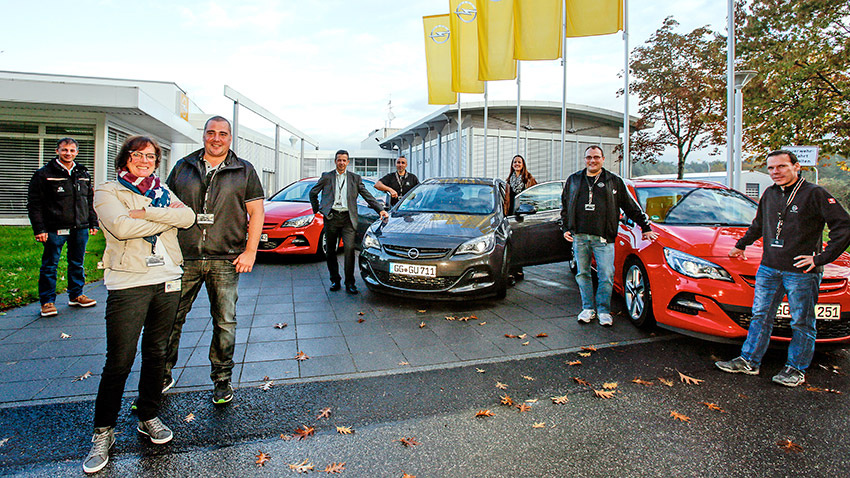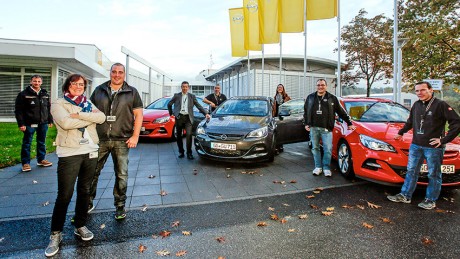Eco-Training. It sounds pretty dull the first time you hear it, but that’s way off the mark! It’s not about moseying around the Opel Test Center in Dudenhofen at snail’s pace. It’s more about finding yourself suddenly driving into another steep bend that looks a lot like a slot-car track. And the camouflaged prototype that zips by on the left at 240 kph gets your pulse racing even faster.
Here’s the Opel Eco-Training course in four steps:
1. First comes the theory
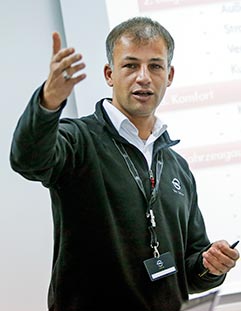
What’s on the agenda today? Instructor Ali Kocak gives the details.
The four course participants – all of them Opel employees who won a place in the course in a company contest – sit opposite four seasoned instructors in the training room. First comes some information on how to save fuel, such as by reducing the car’s electricity generation and checking the air pressure in the tires. On the first lap, the participants have a chance to get used to the car and what the test center has to offer, with its torture tracks, performance area and the high-speed circle track.

In doing so, they can provide a sample of their normal driving style for comparison with their performance on the following laps. The track is based on real driving conditions in Germany’s upland regions. Then it’s time to get out onto the track. Each team of two gets a diesel Astra Sports Tourer with 192 hp and six-speed transmission.
2. Just go for it

Driving slower is definitely not among the range of options – instead, they need to drive more efficiently to save fuel.
During the drive, the instructor tells the participants how fast they should drive and where they should stop, and various measurements are taken. After the results from the diagnosis device have been read out, the teams discuss how they might optimize their performance. They focus on driving time, engine speed, acceleration, braking, shifting gears and, of course, how these factors influence fuel consumption. Driving slower is definitely not among the range of options – instead, they need to drive more efficiently to save fuel. One of the instructors gives them a driving demonstration to use as a reference point. Both teams have room for improvement when it comes to fuel economy.
Advice: Brake less and accelerate less.
Results after the first lap
Martina Stahl, a capacity analyst who has worked at Opel for 39 years, is a whopping 61 percent above the fuel consumption target. She’s astonished, because she didn’t think she was overdoing it when it came to acceleration. The analysis shows that her acceleration phases were too long. Instructor Sven Albrecht gives her some advice: “Brake less and accelerate less. Just let it run and sail down the track.” Every braking maneuver uses energy and makes it necessary to accelerate again, he explains. It’s just like riding a bike: Keep your speed steady without using much power, and use your momentum wherever you can.
Tobias Hellbauer, GMS coordinator and an Opel employee since 1999, is also 53 percent above the reference consumption target. Hellbauer lost a few points during acceleration because of the unfamiliar clutch. He wants to improve on this in the next round.
On the other team, Jörg Pohlers, a mechanical engineer who works in press engineering and scheduling, looks like he’s doing a bit better – he’s 41 percent above the reference target. And Juliane Bremerich, who works in component sales, achieved the best result in the first round at just 32 percent above the fuel consumption target.
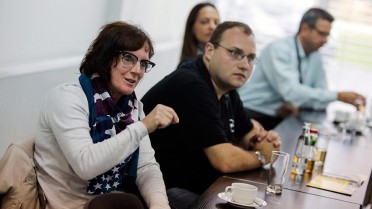
In theory: Martina Stahl asks for details.
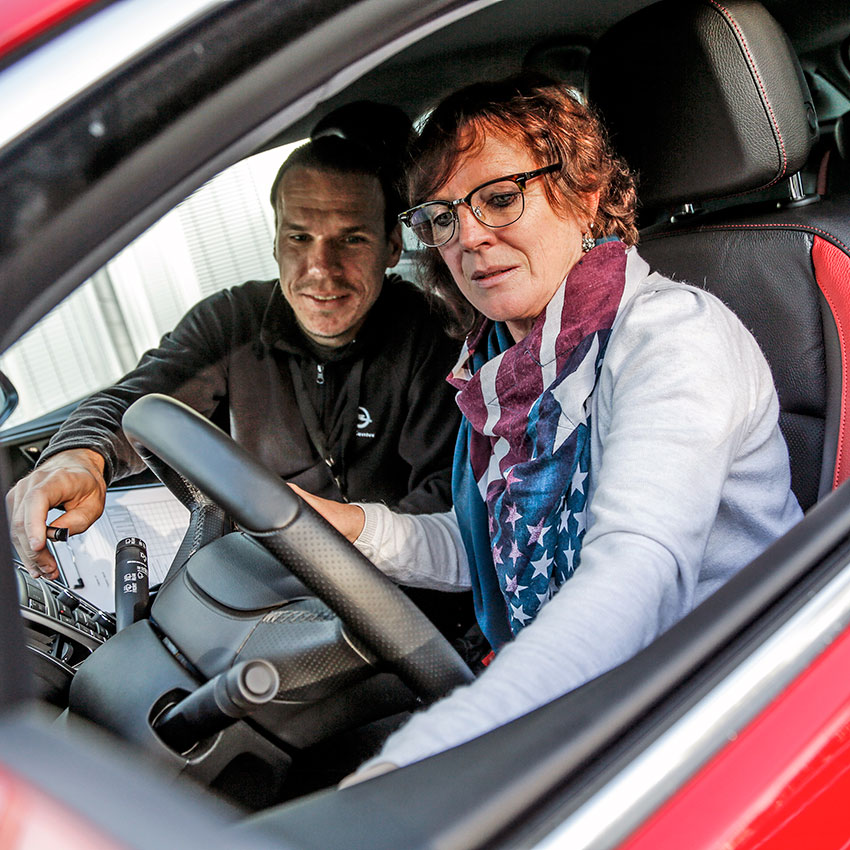
In practice: Instructor Sven Albrecht gives advice.
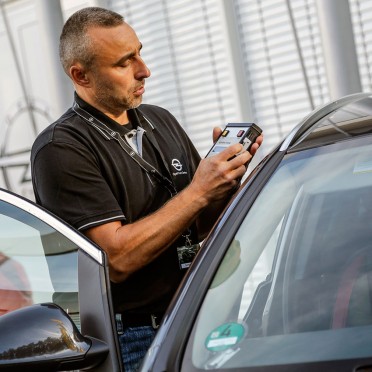
The digital way: Instructor Gottfried Barth uses the diagnosis device.
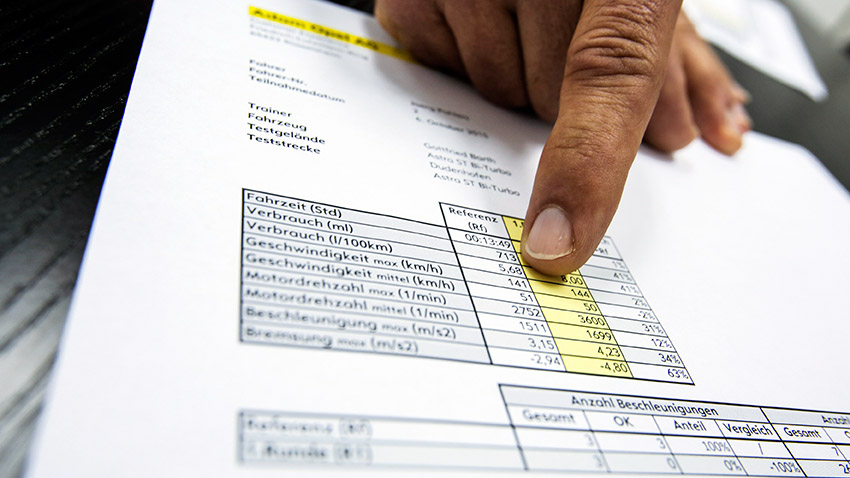
The analog way: Analyzing the drives.
3. Now it really counts

Make sure to stick to the optimal engine speed of between 1,200 and 3,000 rpm.
After receiving personal tips from the instructors, the participants move into the second round. They’ve become ambitious now – they all want to come as close as possible to the reference values. In the second round, the instructors give even more guidance: Make sure to stick to the optimal engine speed of between 1,200 and 3,000 rpm, shift up a gear, disengage the clutch, let it roll, gather momentum before the slope, and keep the speed steady.
As in the first round, the drivers have to contend with cobblestones and bumps of all sorts, old concrete surfaces and quiet new asphalt, manage their way through hairpin turns, hit the high-speed bend at 140 kph, climb up a 30-degree slope and then come down again. Now that they’re trying to brake less and use the car’s rolling momentum as much as possible, they’re clearly able to zip through the bends much more briskly than before. After the second round, the participants are excited to find out their new results. And how did they do? Their new consumption values are up to 17 percent lower than the results of the first lap.
4. The final
It’s time for some more quick tips, and then the final round starts to see if they can improve on what they’ve achieved so far. At the end of the half-day event, the values measured in all the rounds are compared and documented. All participants have improved their values by double-digit amounts compared to the first round, thanks to the new driving methods they’ve learned – the top improvement result is just under 30 percent.
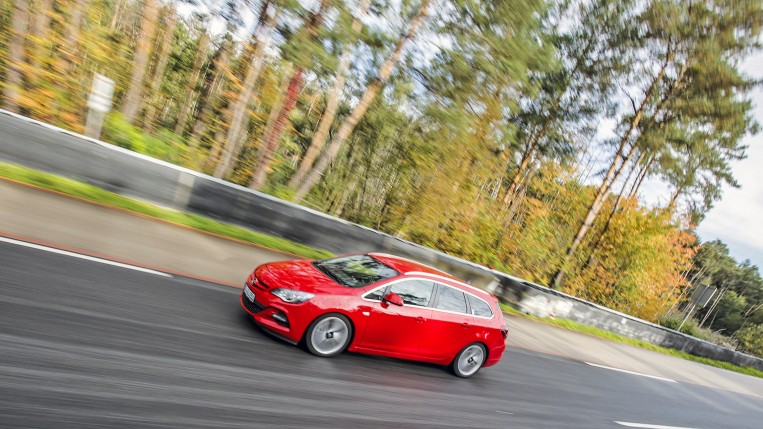
More information on Eco-Trainings as well as other Opel driver trainings are available here (in German).

Last update October 2015
